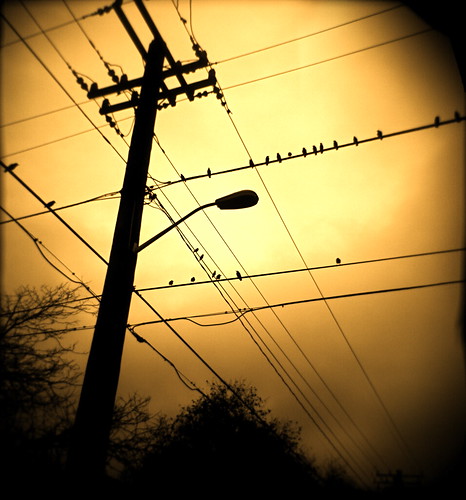This month, backyard gardeners on the Hill are engaging in a well-established summer tradition: grumbling about starlings. These birds are abundant in the neighborhood and they’re happy to eat most things gardeners try to grow for themselves.
The European starling is a dark, speckled bird with greasy-looking iridescent feathers. It’s one of the most maligned bird pests in North America, not only because of its voracious appetite, but also because it spreads disease and sometimes forcibly evicts other, rarer birds from nest holes.
Like many of our avian neighbors on Capitol Hill—including American crows, cliff swallows, and Anna’s hummingbirds—European starlings thrive in a disturbed human environment. The starlings’ success story is unusual, however, because it can be traced back to the handiwork of one particular guy.
A little over a century ago, a wealthy New Yorker named Eugene Schieffelin hatched a scheme to import all of the birds mentioned in Shakespeare’s plays into North America. Starlings made the list because they were mentioned in Henry IV, Part I.
Most of the birds Schieffelin tried to import simply starved or froze to death in the foreign environment. When he released about a hundred pairs of starlings in 1890 and 1891, he had no reason to believe they would experience a different fate. When the starlings survived and began to breed, he and his friends celebrated.
As it turned out, starlings were uniquely well-suited to life in North America. Among other useful adaptations, they have especially strong muscles around their bills. They can shove their beaks into hard-packed or frozen ground and then open their mouths, thus loosening the dirt to get at food sources many other kinds of birds can’t reach.
Within a couple of decades after Schieffelin released the first starlings in New York, Americans had stopped celebrating them and started trying to eradicate them. Nevertheless, the birds spread rapidly across the continent. By 1950 they reached the West Coast, and by 1970 they’d colonized Alaska. Today the North American population of starlings is estimated at more than 200 million.
The writer George Laycock writes, “Starlings do nothing in moderation.” This may be true, but if the list of failed anti-starling warfare techniques is any indication, then the same distinction applies to people, too. Over the last century, Americans have tried to get rid of starlings by eating them, firing rockets at them, blasting them with recordings of owl calls, putting itching powder in their nests, and—my personal favorite—using teddy bears as scarecrows.
In spite of these efforts, the starlings are clearly here to stay. But when you catch them in your blueberry patch this month, don’t blame them too much. Instead, place the credit where it’s due: on Eugene Schieffelin.
Interested in learning more?
- Check out the European starling page at the Cornell Lab of Ornithology.
- Starlings are great mimics, which means they can imitate the calls of other birds. You can listen to some of their sounds at the Macaulay Library of Natural Sounds.
- For other accounts of the history of the European starling in the United States, click here and here.
- And for the literary reader, here’s the full text of Henry IV, Part I, in which Hotspur says, “I’ll have a starling shall be taught to speak/Nothing but Mortimer…”
Previous Aviary Posts
- Capitol Hill Aviary | Annoying Hill crows are actually smart little bird brains
- Swallows pursue unlicensed construction project beneath 520 bridge
- Hill welcomes avian arrivals from the tropics
- More…
Melissa Koosmann is a freelance writer and resident of Capitol Hill. She writes about education, culture, gardening and nature — and, sometimes, birds for CHS.




I thoroughly enjoy reading your posts. Thanks for the education!
Melissa, thanks for the wonderful synopsis …always look forward to your informative essays on our fine feathered friends.
Nice cautionary tale to remind us that certain bird-brained people who introduce invasive species for their own purposes often wreak havoc on native environments.
Thank you Melissa! I always learn so much from your articles. It makes going for walks and bird watching around the neighborhood much more interesting.
Thanks for the kind words. I’ve been out on vacation, but it was fun to come home to read these.
I enjoyed reading your post, thanks!
Minnesota starlings come in waves to our yard for a couple of days at a time, on an irregular schedule. Voraciously they clean out our bird feeder in just a few minutes, if we let them. To stop them, we place a plastic bag over the top and tie it shut on the pole. This, of course, prevents our other friendly birds from eating, but those have to sacrifice and wait for a couple days to eat again. It’s a real comedy show to watch the frustrated starlings try to sit on, or eat from, the covered feeder, just after they have learned how good the seeds in there taste. Within a day or so they give up and leave. Hurray!
Funny. I stop loading my feeders here in Seattle during the cherry season. The starlings come around to eat the cherries, and they unload the feeders at the same time.